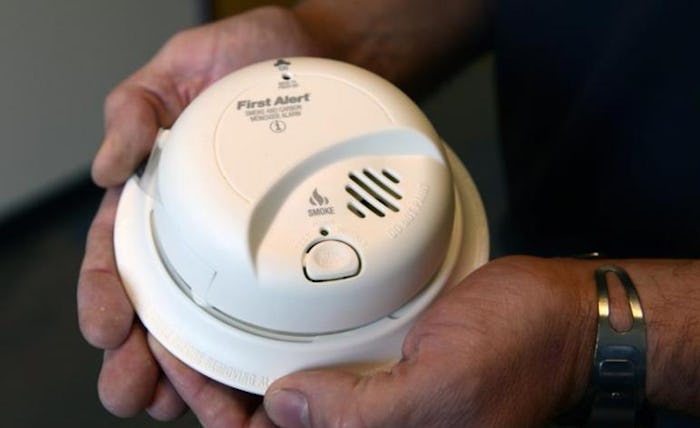Life
Heads Up, You're Probably Using Your Smoke & Carbon Monoxide Detector Wrong
The statistics revolving around smoke and carbon monoxide detectors — their misuse, neglect, or their absence entirely — are harrowing. In New York City right now, there's such a push to stop the deaths that occur when they're not used or used improperly that there are PSAs running during primetime television produced by the fire department and city. While they're not complicated, are you using your smoke and carbon monoxide detector wrong? If it's not in the proper location or if there are not enough of them., you could be.
Carbon monoxide (CO) is an odorless gas that is distinctly insidious because it lulls you to sleep and relaxes you before it eventually suffocates you, noted the Centers for Disease Control and Prevention. That's why there's been a real push to get families to use them, leading to the popularity of the combined CO/smoke detector. However, they have to be placed properly, maintained regularly, and you have to choose the right model for your home.
According to statistics, 37 percent of deaths in house fires happen in homes where there was no detector or it wasn't properly maintained, noted MySmokeAlarm.org. Also, there are an average of 430 deaths per year due to CO poisoning. That's entirely too many preventable deaths. Therefore, here are five ways you're using your CO/smoke detector incorrectly, and how to fix it.
1They're Not In The Right Location
According to experts, they need to be at least 5 feet from the ground, on every level of the home, and within 15 feet of every bed, explained New York City's 311 services. Not every bedroom — every bed. If you have a palatial suite in your McMansion, get thee an alarm for your room.
2You're Not Maintaining It
This is especially true for dusty climates and alarms around the kitchen. They can and do get gummed up with gunk and grime that floats in the air, so make sure you dust them and wipe them off. I once looked at a smoke detector on the ceiling in my office, and it was basically covered in grit and dust. Gross, right?
3The Batteries Are Old
Batteries in smoke and carbon monoxide detectors need changed at least every six months to be safe, if they're not hardwired, according to the FDNY. If they are hardwired, they need to be tested every six months and there is a button on the detector that does just that. Push it in, wait for the beep. It's that simple.
4It's Old
Technology keeps changing and improving. Detectors are more sensitive and reliable than they've ever been. If yours is more than five years old, replace it. Like any small appliance, they're prone to failure after a few years. They're not expensive and they're easy to install.
5You Don't Have The Right Model For Your Needs
I am deaf. My daughter is hard of hearing. We need our alarms to flash bright lights at our face to be able to hear them. If you or your loved one can't hear high pitches or suffer from hearing loss, you need to make sure you have an adaptive device. They're only around $10 more per unit, and everyone in the house needs to be safe. If you're a hard sleeper, they also make smoke alarms that will shake the heck out of your bed. You might wet yourself, but you'll be alive.
Check out Romper's new video series, Romper's Doula Diaries:
Watch full episodes of Romper's Doula Diaries on Facebook Watch.
